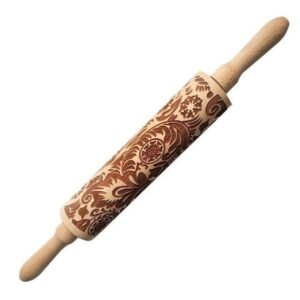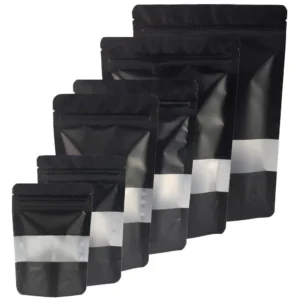Introduction
Did you know that chow mein is not just a popular Chinese dish, but also a global favorite? This delectable stir-fried noodle dish has captured the hearts and taste buds of people worldwide. Packed with a delightful combination of flavors and textures, chow mein is typically served with an array of fresh vegetables and protein options. From succulent chicken to tender beef or even vegetarian variations, there are endless types of chow mein to satisfy every palate.

Origins and History of Chow Mein
Chow Mein, a popular Chinese dish enjoyed worldwide, has a fascinating history that dates back to ancient times. Originating in Northern China during the Han Dynasty, it eventually made its way across the Pacific Ocean to the United States through Chinese immigrants in the 19th century.
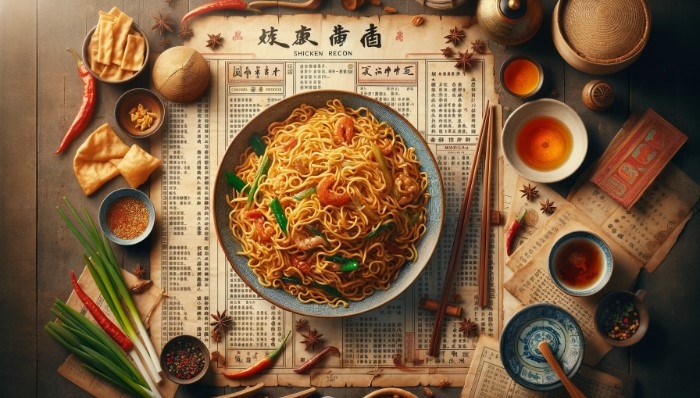
Originated in Northern China
Chow Mein traces its roots back to Northern China, where it was first created during the Han Dynasty. The dish consists of stir-fried noodles combined with various vegetables, meat, and sometimes seafood. It quickly gained popularity for its delicious flavors and satisfying texture.
Brought to the United States by Chinese Immigrants
During the 1800s, many Chinese immigrants arrived in the United States seeking better opportunities. Along with their culture and traditions, they brought their culinary expertise, including the beloved Chow Mein recipe. As they settled in cities like San Francisco and New York City, Chow Mein became a staple on Chinese restaurant menus.
Regional Variations Across China
While Chow Mein is widely known as a popular Chinese dish, it’s important to note that there are regional variations across different parts of China. Each region puts its own spin on this classic dish by incorporating local ingredients and flavors. For example, Cantonese-style Chow Mein features crispy noodles topped with stir-fried vegetables and savory sauces.
Evolution Over Time
As Chow Mein traveled from China to America and beyond, it underwent further evolution to cater to local tastes. In Western countries like the United States and Canada, you’ll often find variations that include additional ingredients such as chicken or beef alongside vegetables. These adaptations reflect how cuisine adapts and transforms based on cultural influences.
Exploring the Versatility of Chow Mein Dishes
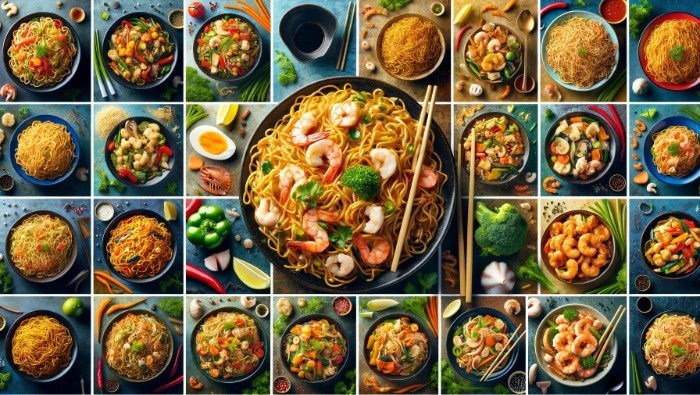
Chow mein is a versatile and flavorful dish that can be customized to suit various tastes and dietary preferences. Whether you prefer egg or wheat noodles, are a vegetarian looking for plant-based options, or have specific protein preferences, chow mein has got you covered. Let’s dive into the different ways you can enjoy this popular dish.
Various Types of Noodles
Chow mein can be made with different types of noodles, such as egg noodles or wheat noodles. The choice of noodle affects the texture and taste of the dish. Egg noodles offer a slightly chewy texture, while wheat noodles provide a more hearty bite. Whichever type you choose, both add depth and substance to your chow mein.
Vegetarian Options
If you follow a vegetarian diet, fret not! Chow mein can easily be adapted to suit your preferences. Instead of meat, tofu or mushrooms can be used as protein alternatives. These ingredients absorb the flavors of the sauce and spices beautifully, resulting in a satisfying vegetarian chow mein that doesn’t compromise on taste.
A Bounty of Vegetables
One of the great things about chow mein is its ability to accommodate an array of vegetables. Bell peppers, carrots, bean sprouts – you name it! You can mix and match your favorite veggies to create a colorful and nutritious meal. The combination of crunchy vegetables adds freshness and texture to each bite.
Customizable Proteins
Chow mein allows for flexibility. Whether you’re a fan of chicken, beef, shrimp, or pork – there’s something for everyone. You can choose your preferred protein or even combine them for added variety. The proteins lend their unique flavors to the dish while complementing the other ingredients perfectly.
The Perfect Sauce Mixture for Chow Mein
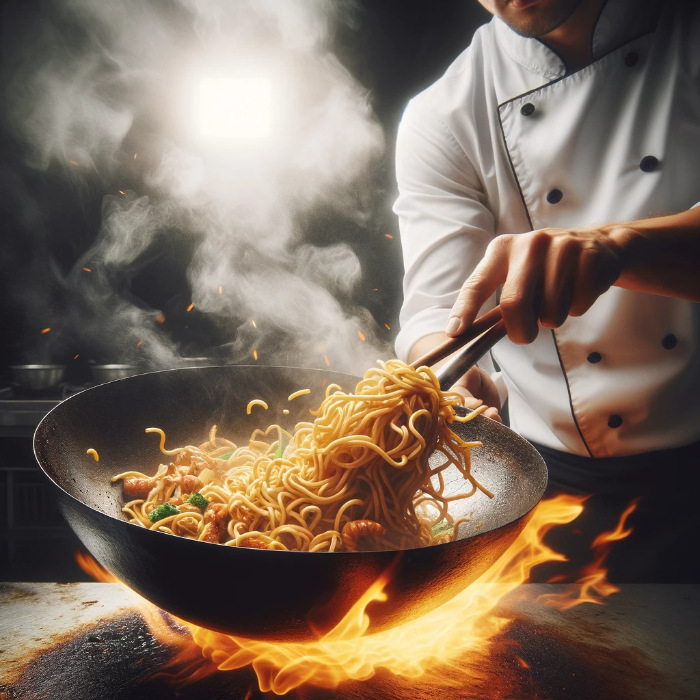
To make the best chow mein, you need a delicious sauce that brings out the flavors of the dish. The perfect sauce mixture consists of soy sauce, oyster sauce, sesame oil, and sugar.
Soy Sauce
Soy sauce is an essential component of chow mein sauce. It provides a salty and savory flavor that enhances the taste of the noodles and vegetables.
Oyster Sauce
Oyster sauce adds richness and depth to the dish with its umami flavor. It complements the other ingredients perfectly, giving your chow mein a deliciously complex taste.
Sesame Oil
Toasted sesame oil brings a nutty aroma and flavor to your chow mein. Just a small amount can elevate the overall taste profile of your dish.
Sugar
A touch of sugar balances out the savory flavors in the sauce, providing a subtle sweetness that rounds off all the flavors harmoniously.
By combining these simple ingredients in just the right amounts, you’ll have a thick and flavorful chow mein sauce that will take your dish from good to great!
So go ahead and experiment with this wonderful recipe by adding your favorite proteins or veggies—chicken, beef, shrimp, or even tofu—and enjoy your homemade chow mein bursting with mouthwatering flavors!
Stir-Frying Noodles: Techniques for Perfectly Cooked Chow Mein
To achieve the perfect chow mein, it’s crucial to master the art of stir-frying noodles. Follow these techniques to ensure your noodles are cooked to perfection:
Avoid Overcooking Noodles
When stir-frying chow mein, it’s important not to overcook the noodles. They should be cooked until they are al dente, which means they still have a slight bite to them. Overcooked noodles can become mushy and lose their texture.
Stir-Fry on High Heat
To prevent your noodles from becoming soggy or mushy, stir-fry them on high heat for a short period. The high heat helps to quickly cook the noodles while maintaining their firmness and preventing them from sticking together.
Gently Toss Noodles
When stir-frying chow mein, gently toss the noodles in the wok or pan. This ensures even cooking and prevents them from clumping together or sticking to the surface. Use a pair of tongs or chopsticks to gently separate and toss the noodles as they cook.
Add Moisture if Needed
If you find that your noodles are drying out during stir-frying, add a splash of water or broth to moisten them. This will help prevent them from sticking and allow for more even cooking.
Variations and Regional Influences on Chow Mein
Hong Kong-style chow mein is a popular variation that features crispy pan-fried noodles topped with a saucy stir-fry. The noodles are cooked until golden brown and crunchy, providing a delightful texture contrast to the tender vegetables and meat. This style of chow mein is often served as a standalone dish or as part of a multi-course meal in Cantonese cuisine.
On the other hand, Americanized versions of chow mein have their own unique twists. These versions typically include more sauce and additional ingredients like baby corn or water chestnuts for added flavor and texture. The result is a heartier dish that caters to American tastes.
Singaporean chow mein takes things up a notch by incorporating spicy flavors into the mix. With the addition of curry powder or chili paste, this version delivers a fiery kick that sets it apart from other variations. It’s perfect for those who enjoy bold and vibrant flavors in their meals.
For those looking for something truly distinctive, Taiwanese chow mein offers an intriguing twist. This variation often includes seafood like squid or clams, adding an oceanic touch to the dish. The combination of seafood with the stir-fried noodles creates a unique flavor profile that seafood lovers will appreciate.
Thinking Like a Cantonese Chef: Cantonese Gai See Chow Mein Recipe
Gai See Chow Mein is a classic Cantonese dish that will transport your taste buds to the vibrant streets of Hong Kong. This delectable stir-fried noodle dish features crispy egg noodles topped with a medley of stir-fried vegetables, meat, and seafood. Let’s dive into what makes this dish so special.
Crispy Noodle Base
The star of Gai See Chow Mein is undoubtedly the crispy egg noodles. These thin and delicate noodles are first deep-fried until they turn golden brown and become wonderfully crispy. This technique creates a sturdy base for the toppings while adding a delightful crunch to each bite.
Flavorful Toppings
Once the noodles are fried to perfection, it’s time to load them up with an array of flavorful toppings. Cantonese chefs showcase their culinary expertise by stir-frying an assortment of vegetables, such as bok choy, mushrooms, and bean sprouts. The addition of tender slices of chicken, succulent shrimp, or juicy beef further elevates the dish’s taste profile.
Contrasting Textures
One of the reasons why Gai See Chow Mein remains a popular choice in Cantonese cuisine is its contrasting textures. The combination of crispy noodles with tender vegetables and succulent meats creates a delightful interplay between softness and crispiness in every mouthful.
Skillful Technique
Preparing Gai See Chow Mein requires skillful technique to ensure that each component is cooked perfectly. The noodles must be fried just long enough to achieve crispness without becoming overly greasy or burnt. The stir-fried toppings must be cooked quickly over high heat to retain their freshness while developing rich flavors.
Nutrition Information: Understanding the Health Benefits of Chow Mein
Chow mein, a popular Chinese dish, can be a nutritious option when packed with colorful vegetables and lean protein sources. Let’s delve into the nutrition information to understand its health benefits.
Vegetable-Packed Varieties Offer Essential Nutrients
Chow mein that is loaded with vibrant vegetables provides an array of essential vitamins, minerals, fiber, and antioxidants. These nutrients are crucial for maintaining overall health and well-being. Incorporating vegetables like bell peppers, broccoli, carrots, and cabbage not only adds flavor but also boosts the nutritional value of the dish.
Lean Protein Sources Support Muscle Growth
To make chow mein more satisfying and nutritious, it’s common to add lean protein sources such as chicken or tofu. These ingredients provide essential amino acids necessary for muscle growth and repair. Including protein in your chow mein helps keep you feeling full for longer periods while supporting your body’s vital functions.
Portion Control Is Key
While chow mein can offer health benefits when prepared with nutritious ingredients, it’s important to practice portion control. Excessive consumption of oil or sodium can negatively impact the overall healthiness of the dish. Opting for smaller portions or sharing a plate with others can help maintain a balanced intake.
Delighting in the World of Chow Mein
Chow mein, oh chow mein! It’s time to embark on a culinary adventure that will tantalize your taste buds and leave you craving for more. This beloved dish offers a delightful combination of flavors and textures that are sure to satisfy even the pickiest eaters. So, let’s dive right in and explore the wonderful world of chow mein!
Diverse Flavors and Textures
One of the most exciting aspects of chow mein is its diverse range of flavors and textures. From the savory umami notes of soy sauce to the crispiness of stir-fried noodles, each bite is a symphony of deliciousness. Whether you prefer a vegetable medley or succulent seafood, there’s a chow mein variation to suit every palate.
Regional Variations
Venturing into different regional variations allows you to expand your culinary horizons and deepen your understanding of Chinese cuisine. Each region puts its own unique twist on this beloved dish, incorporating local ingredients and cooking techniques. From Cantonese-style with thin crispy noodles to Shanghai-style with thick chewy noodles, there’s always something new to discover.
Cooking Creativity at Home
Why not bring the joy of chow mein into your own kitchen? Cooking chow mein at home not only allows for creativity but also lets you customize it according to your personal preferences. You can experiment with different combinations of vegetables, proteins, and sauces until you find your perfect blend. Plus, it’s a fun activity that can be enjoyed by chefs of all skill levels.
A Versatile Dish for All Ages
Chow mein knows no boundaries. Loved by kids and adults alike, this versatile dish brings joy to many dinner tables around the world. Whether it’s a quick weeknight meal or a special occasion feast, chow mein never fails to impress.
Conclusion
The different variations and regional influences on chow mein, it’s time to let your creativity shine in the kitchen. Experiment with different ingredients, flavors, and techniques to put your own unique spin on this classic dish. Whether you prefer a Cantonese Gai See Chow Mein or want to explore other regional styles, there are endless possibilities waiting for you.
FAQs
Can I use other types of noodles instead of egg noodles?
Absolutely! While egg noodles are traditionally used in chow mein, you can experiment with other types of noodles as well. Try using rice noodles for a gluten-free option or even spaghetti if that’s what you have on hand. Just keep in mind that different types of noodles may require adjustments in cooking time.
Can I make vegetarian or vegan chow mein?
Definitely! Chow mein is incredibly versatile. To make a vegetarian version, simply omit the meat or substitute it with tofu or tempeh. For a vegan option, use vegetable-based sauces and ensure that all ingredients are free from animal products.
How long does it take to cook chow mein?
The cooking time for chow mein varies depending on the recipe and the specific ingredients used. Generally, it takes around 20-30 minutes to prepare and cook a delicious plate of chow mein. However, it’s always a good idea to read through the recipe instructions beforehand and have all your ingredients prepped and ready to go for a smoother cooking process.
Can I freeze leftover chow mein?
Yes, you can freeze leftover chow mein! Allow it to cool completely before transferring it into an airtight container or freezer bag. It will stay fresh in the freezer for up to 3 months. When you’re ready to enjoy it again, simply thaw it overnight in the refrigerator and reheat it in a pan or microwave until heated through.
How can I customize my chow mein with additional vegetables?
Adding extra vegetables is a fantastic way to enhance the flavor and nutritional value of your chow mein. Feel free to experiment with different veggies like bell peppers, broccoli, carrots, snap peas, or mushrooms.
Frequently Linked Pages
1. Dumplings Near Me – Dumplings Near Me: Best Deals & Delivery Options
2. Chop Suey – Chop Suey: A Delicious Culinary Adventure In Every Bite
3. Mapo Tofu – Mapo Tofu Recipe: The Authentic and Delicious Way!
4. Kung Pao Chicken – Kung Pao Chicken Recipe: Spicy Delight!
5. Wonton – Wonton Making: The Ultimate Guide
6. Peking Duck –Peking Duck Recipe: Easy Home Version
7. Chinese Food – Chinese Food: A Gastronomic Adventure into Authentic Oriental Flavors
8. Chow Mein Recipe – Chow Mein Recipe: Quick & Easy Chicken Delight!
9. Chow Mein Noodles – Chow Mein Noodles: Delicious Recipe for the Best Chicken Chow Mein!
10. Chow Mein vs Lo Mein – Chow Mein vs Lo Mein: Decoding the Differences in Chinese Noodle Delights
11. Sashimi – sashimi: A Guide To The Delicate Art Of Raw Seafood




